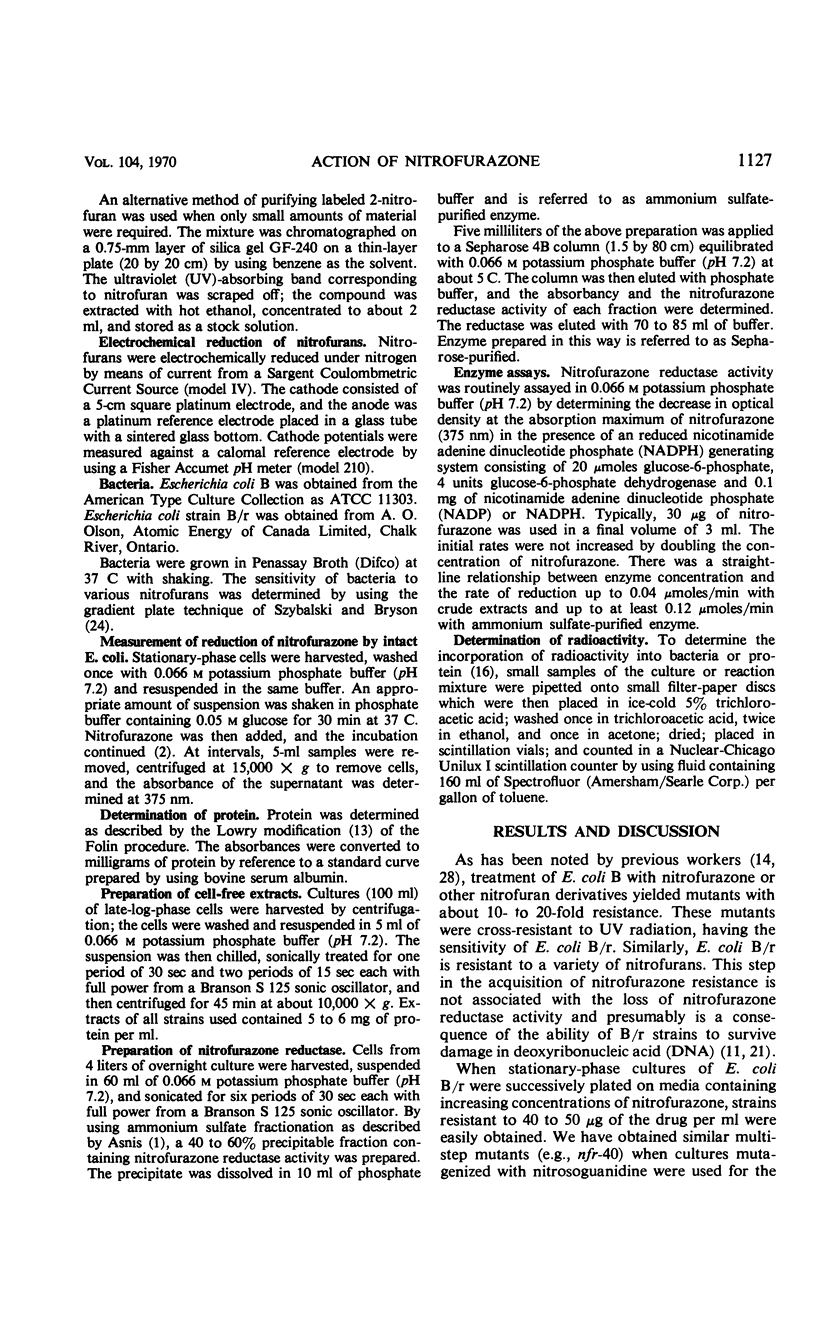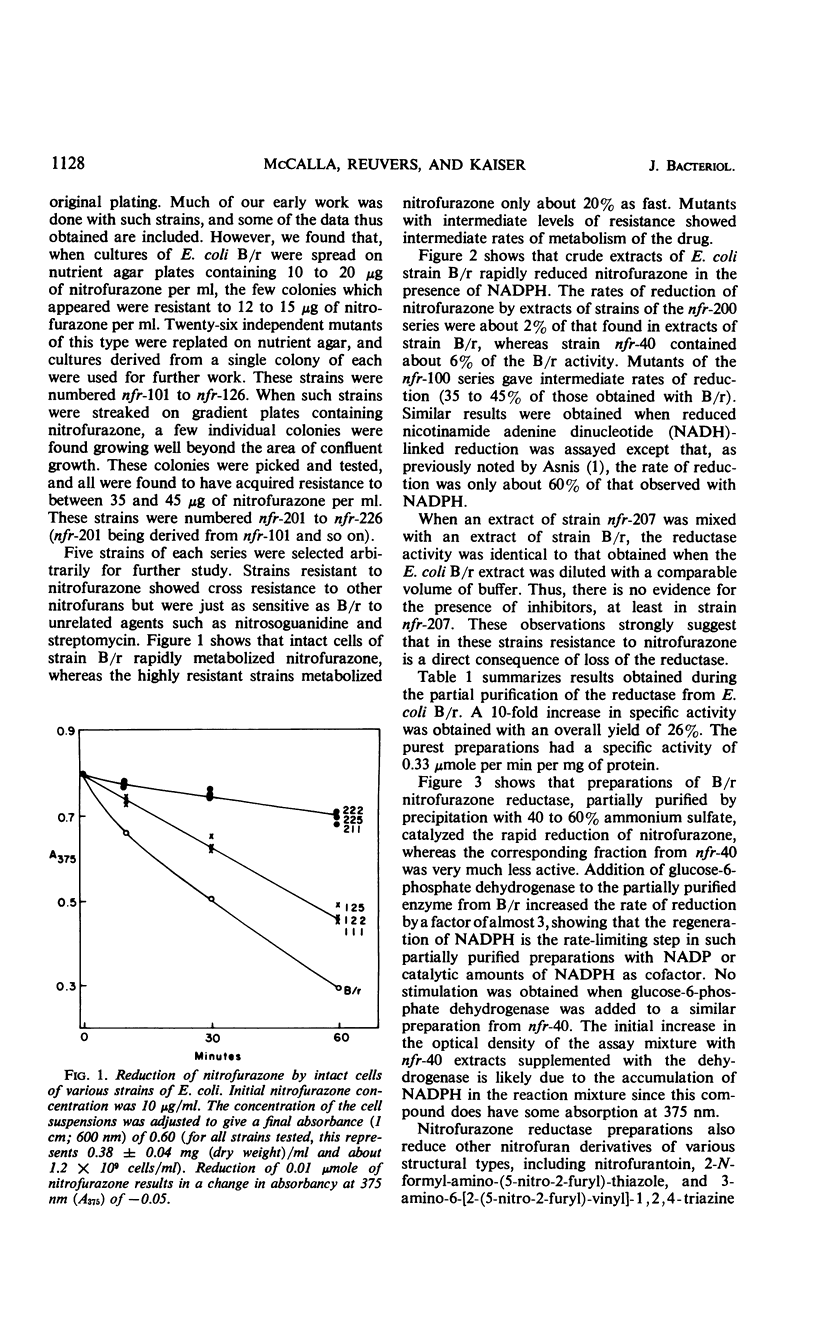Abstract
When Escherichia coli strain B/r is exposed to 10 to 20 μg of nitrofurazone per ml, mutants with roughly threefold resistance are obtained. Treatment of these mutants with higher concentrations of nitrofurazone yields strains with six- to seven-fold resistance over strain B/r. Each of these steps toward nitrofurazone resistance is accompanied by loss of soluble nitrofurazone reductase activity. When sensitive bacteria are exposed to labeled nitrofurazone or labeled 2-nitrofuran, a considerable amount of radioactivity becomes bound to the cold trichloroacetic acid-insoluble fraction. Very little activity becomes bound in the mutants with six- to seven-fold resistance; mutants with intermediate resistance show intermediate levels of binding. Partially purified nitrofurazone reductase preparations catalyze the conversion of nitrofurazone to compounds which bind to protein and are not removed by prolonged dialysis against 8 m urea or by cold acid. Nitrofurazone reduced by xanthine oxidase or electrolytically reduced also yields compounds which react with protein to form stable derivatives.
Full text
PDF








Selected References
These references are in PubMed. This may not be the complete list of references from this article.
- ASNIS R. E. The reduction of Furacin by cell-free extracts of Furacin-resistant and parent-susceptible strains of Escherichia coli. Arch Biochem Biophys. 1957 Jan;66(1):208–216. doi: 10.1016/0003-9861(57)90551-9. [DOI] [PubMed] [Google Scholar]
- Ertürk E., Price J. M., Morris J. E., Cohen S., Leith R. S., Von Esch A. M., Crovetti A. J. The production of carcinoma of the urinary bladder in rats by feeding N-[3-(5-nitro-2-furyl)-2-thiazolyl]formamide. Cancer Res. 1967 Nov;27(11):1998–2002. [PubMed] [Google Scholar]
- Gavin J. J., Ebetino F. F., Freedman R., Waterbury W. E. The aerobic degradation of 1-(5-nitrofurfurylideneamino)-2-imidazolidinone (NF-246) by Escherichia coli. Arch Biochem Biophys. 1966 Feb;113(2):399–404. doi: 10.1016/0003-9861(66)90205-0. [DOI] [PubMed] [Google Scholar]
- Green M. H., Donch J., Greenberg J. An immediate effect of inhibition of DNA synthesis on cell division in a Lon strain of Escherichia coli. Mutat Res. 1969 Sep-Oct;8(2):409–411. doi: 10.1016/0027-5107(69)90018-9. [DOI] [PubMed] [Google Scholar]
- HARTMAN P. E., MUDD S., PAYNE J. I., PHILLIPS A. W. Cytological analysis of ultraviolet-irradiated Escherichia coli. III. Reactions of a sensitive strain and its resistant mutants. J Bacteriol. 1956 Oct;72(4):461–472. doi: 10.1128/jb.72.4.461-472.1956. [DOI] [PMC free article] [PubMed] [Google Scholar]
- Kriek E. On the interaction of N-2-fluorenylhydroxylamine with nucleic acids in vitro. Biochem Biophys Res Commun. 1965 Sep 22;20(6):793–799. doi: 10.1016/0006-291x(65)90088-4. [DOI] [PubMed] [Google Scholar]
- LOWRY O. H., ROSEBROUGH N. J., FARR A. L., RANDALL R. J. Protein measurement with the Folin phenol reagent. J Biol Chem. 1951 Nov;193(1):265–275. [PubMed] [Google Scholar]
- MCCALLA D. R. EFFECT OF NITROFURANS ON THE CHLOROPLAST SYSTEM OF EUGLENA GRACILIS. J Protozool. 1965 Feb;12:34–41. doi: 10.1111/j.1550-7408.1965.tb01808.x. [DOI] [PubMed] [Google Scholar]
- MCCALLA D. R. NITROFURAN DERIVATIVES AS RADIOMIMETIC AGENTS: CROSS-RESISTANCE STUDIES WITH ESCHERICHIA COLI. Can J Microbiol. 1965 Apr;11:185–191. doi: 10.1139/m65-024. [DOI] [PubMed] [Google Scholar]
- McGrath R. A., Williams R. W. Reconstruction in vivo of irradiated Escherichia coli deoxyribonucleic acid; the rejoining of broken pieces. Nature. 1966 Oct 29;212(5061):534–535. doi: 10.1038/212534a0. [DOI] [PubMed] [Google Scholar]
- Miller E. C., Miller J. A. Mechanisms of chemical carcinogenesis: nature of proximate carcinogens and interactions with macromolecules. Pharmacol Rev. 1966 Mar;18(1):805–838. [PubMed] [Google Scholar]
- Morris J. E., Price J. M., Lalich J. J., Stein R. J. The carcinogenic activity of some 5-nitrofuran derivatives in the rat. Cancer Res. 1969 Dec;29(12):2145–2156. [PubMed] [Google Scholar]
- SZYBALSKI W., BRYSON V. Genetic studies on microbial cross resistance to toxic agents. I. Cross resistance of Escherichia coli to fifteen antibiotics. J Bacteriol. 1952 Oct;64(4):489–499. doi: 10.1128/jb.64.4.489-499.1952. [DOI] [PMC free article] [PubMed] [Google Scholar]
- TAYLOR J. D., PAUL H. E., PAUL M. F. Metabolism of the nitrofurans. III. Studies with xanthine oxidase in vitro. J Biol Chem. 1951 Jul;191(1):223–231. [PubMed] [Google Scholar]
- TERAWAKI A., GREENBERG J. EFFECT OF SOME RADIOMIMETIC AGENTS ON DEOXYRIBONUCLEIC ACID SYNTHESIS IN ESCHERICHIA COLI AND TRANSFORMATION IN BACILLUS SUBTILIS. Biochim Biophys Acta. 1965 Jan 11;95:170–173. doi: 10.1016/0005-2787(65)90221-2. [DOI] [PubMed] [Google Scholar]
- WATERBURY W. E., FREEDMAN R. INDUCTION OF PHAGE FORMATION BY NITROFURANS. Can J Microbiol. 1964 Dec;10:932–934. doi: 10.1139/m64-125. [DOI] [PubMed] [Google Scholar]
- WOODY-KARRER P., GREENBERG J. RESISTANCE AND CROSS RESISTANCE OF ESCHERICHIA COLI S MUTANTS TO THE RADIOMIMETIC AGENT NITROFURAZONE. J Bacteriol. 1963 Jun;85:1208–1216. doi: 10.1128/jb.85.6.1208-1216.1963. [DOI] [PMC free article] [PubMed] [Google Scholar]
- Zampieri A., Greenberg J. Nitrofurazone as a mutagen in Escherichia coli. Biochem Biophys Res Commun. 1964;14:172–176. doi: 10.1016/0006-291x(64)90249-9. [DOI] [PubMed] [Google Scholar]


